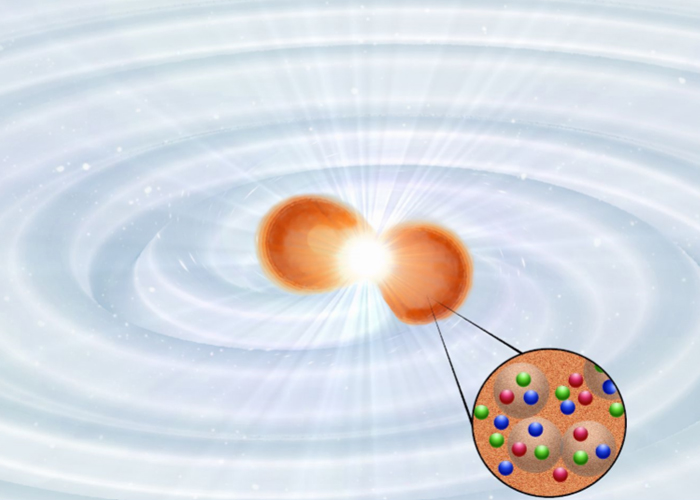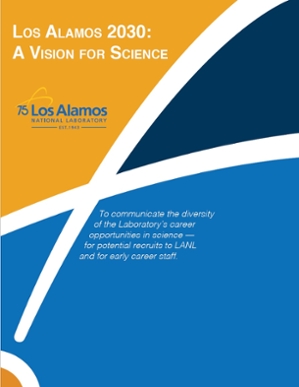Science, Technology, and Engineering
Contact Us
- Deputy Director
- John Sarrao
- Executive Officer
- Angela Mielke
Scientific capabilities for mission excellence
To meet a growing complexity of threats and challenges, the Deputy Director's Office for Science, Technology and Engineering maintains broad and deep science, technology and engineering capabilities throughout its science organizations. These capabilities are leveraged to meet the Laboratory’s diverse national security missions.
Integrating and applying these capabilities rapidly and effectively to meet new challenges—across the Laboratory and with our strategic partners—is a key advantage for the nation in an increasingly urgent security landscape.
Los Alamos 2030: A Vision for Science
A new Los Alamos report, "Los Alamos 2030: A Vision for Science," provides a vision for scientific research at Los Alamos as we look forward over the next one to two decades. The report communicates the diversity of the Laboratory's mission and career opportunities in science for potential recruits to LANL and for early career staff for the near future. Click here to read the Los Alamos 2030 report.
The people in the STE organizations are the key resource for Los Alamos, bringing together the advanced skills and expertise that make up our multidisciplinary capabilities. By strategically applying these scientific and technological capabilities, the Laboratory continues to resolve complex challenges facing the nation.
STE Science Organizations
Chemical, Earth & Life Sciences Directorate
The CELS Associate Lab Directorate is home to a wide diversity of capability-focused groups whose work spans the Laboratory’s major mission areas of stockpile stewardship, global security and energy security.
Physical Sciences Directorate
The PS Directorate’s research experiments stimulate solutions for some of the most intractable national security problems, including nuclear weapons stewardship, homeland security, intelligence & information analysis and nuclear & alternative energy. The directorate's research and experimental facilities span a broad range of complex scientific areas. We often combine forces with colleagues in theoretical physics, high-performance computing, and computational science to formulate experience to validate theories and computational models.
Simulation & Computation Directorate
The SC Directorate applies science-based prediction to nuclear weapon stewardship, the reliable replacement warhead and beyond. The Directorate supports all other current and emerging national security missions, such as threat reduction, intelligence, homeland security, energy, infrastructure, nano science and technology and biological science, as well as most science frontiers from biophysics to astrophysics.
Global Security Directorate
The Global Security Directorate's line and program offices concentrate on nuclear nonproliferation, nuclear counterproliferation, and counter-terrorism focusing on known and emerging threats including bio, cyber, and space. In addition, Global Security leverages the Laboratory’s core technical capabilities to provide our Intelligence, DOD, and DHS partners the ability to meet their national security missions.
In today’s dynamic national security and technical environment, strategic partnerships and collaborations allow the Deputy Director for STE to cost-effectively leverage our research to accomplish programmatic goals. Partnering with academic institutions, industry and other laboratories, we leverage our science and technology for the nation’s benefit.
Laboratory Directed Research and Development (LDRD)
The LDRD Program is a prestigious source of research and development (R&D) funding awarded through a rigorous and highly competitive peer-review process. As the sole source of discretionary R&D funding at the Laboratory, LDRD resources are carefully invested in high-risk, potentially high-payoff activities that build technical capabilities and explore ways to meet future mission needs.
National Security Education Center (NSEC)
NSEC focuses on collaborations for education and strategic research and student opportunities. Its strategic centers, institutes, and education programs are chartered to foster high quality, multi-program and multi-division research efforts, specialized recruiting and strategy development.
Science Resource Office
The Laboratory's Science Resource Office (SRO) programs are the recognized model for driving scientific and technical excellence. SRO builds and maintains a suite of high-quality functions that enable the R&D mission of the Laboratory.
SRO's major activities include
- leading the Lab-wide effort to conduct annual science and technology assessments required by DOE for management of Los Alamos
- managing the Research Library, one of the premier digital libraries in the world, providing state-of-the-art information technology tools to our research community and developing innovative web technologies to further information availability, accessibility and management
- publishing 1663 magazine, which highlights the Lab's forefront research and programmatic activities
- providing support and advocacy for Los Alamos' foreign national community, a critical source of world-class researchers furthering the Lab mission
In addition, SRO facilitates a broad range of multi-faceted activities that promote the science and technology missions of Los Alamos
The Laboratory has established the Science Pillars under four main themes to bring together the Laboratory's diverse array of scientific capabilities and expertise. The Science Pillar concept is the primary tool the Laboratory uses to manage our multidisciplinary scientific capabilities and activities.
Information, Science & Technology for Prediction (IS&T)
The IS&T Pillar is developing IS&T capabilities in computational co-design, data science at scale and complex networks. We are leveraging advances in theory, algorithms and the exponential growth of high-performance computing to accelerate the integrative and predictive capability of the scientific method.
Science of Signatures (SoS)
The SoS Pillar is revolutionizing measurements for threat-specific signatures; discovering signatures that identify and characterize threats, and deploying advanced technology. We are applying science and technology to intransigent problems of system identification and characterization in areas of global security, nuclear defense, energy and health.
Materials for the Future
The Materials Pillar will allow us to predict and create new materials functionality in previously inaccessible extremes. In materials science, we are optimizing materials for national security applications by predicting and controlling their performance and functionality through discovery science and engineering.
Nuclear and Particle Futures (NPF)
In the NPF Pillar, we are integrating nuclear experiments, theory and simulation to understand and engineer complex nuclear phenomena. The NPF Pillar focuses on fundamental advancements in:
- Nuclear and particle science, astrophysics, and cosmology
- Applied nuclear science and engineering
- High energy density plasmas and fluids
- Accelerators and electrodynamics
Complex Natural and Engineered Systems
In the CNES Pillar, our research and development spans from improving engineered systems such as nuclear weapons and the power grid, to understanding the interface of human and engineered systems from the subsurface to space, to studying how complex natural systems such as disease and climate impact humanity.
Weapons Systems
The Weapons System Pillar strengthens the institutional strategic research in capabilities underpinning the Laboratory’s weapons program that address emerging national security challenges.
Our signatures facilities are a critical component for maintaining the vitality and leadership of our science, technology and engineering capabilities for national security.
These facilities support the transformative solutions realized by our employees’ skills and expertise in research and development.
- Dual Axis Radiographic Hydrodynamic Test Facility (DARHT)
- Electron Microscopy Lab
- Ion Beam Materials Lab
- Isotope Production Facility
- Lujan Center
- Dynamic Mesoscale Material Science Capability
- Proton Radiography
- Trident Laser Facility
- Ultracold Neutrons
- Weapons Neutron Research Facility»












